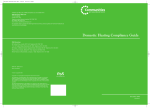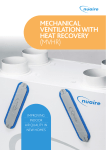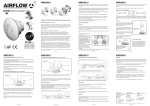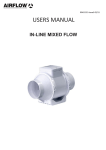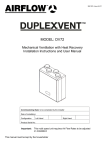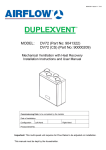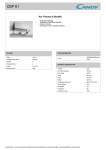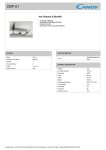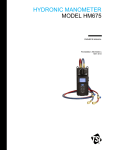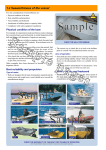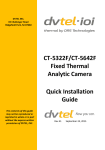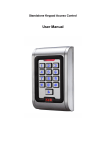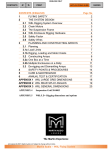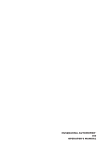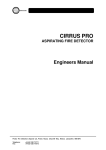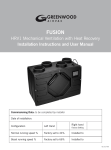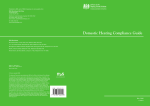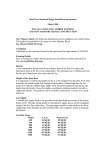Download - Vectaire
Transcript
"WHHR125DC - Aera" Residential Whole House Heat Recovery Unit with Low Energy DC Motor Installation, Operating and Maintenance Instructions "WHHR125DC- AERA" - WHOLE HOUSE HEAT RECOVERY UNIT INSTALLATION AND OPERATING & MAINTENANCE INSTRUCTIONS Safety Notice It is important to read this Instruction Manual carefully before installing or using the product. Following these instructions will ensure that your ventilation system is installed, commissioned and used properly and continues to operate effectively. Vectaire will not be held responsible and will not accept liability for any damage caused to persons or property through failure to follow the guidance provided in this manual. It should always be available with the product for easy reference. WHHR125DC - Aera: 5"/125mm spigot, for dwellings up to 150m2, max capacity 280m3/hr General Information The Vectaire WHHR125DC- Aera heat recovery system provides whole house mechanical ventilation to living areas, bedrooms, kitchen and bathrooms. It extracts stale, contaminated air from kitchens, utility rooms and bathrooms, and uses the heat recovered from this air to warm fresh, incoming air to create a flow of fresh, filtered air throughout the dwelling. The extract and intake air streams are separated to avoid contamination. Cooled outgoing stale air Incoming fresh air The majority of the heat is reclaimed from extracted air and used, via the heat exchange process, to warm incoming fresh air. The system will operate continuously to create a stable, comfortable, healthy environment avoiding the use of excessive energy and saving heat already generated. Outgoing stale air The heat recovery unit must be installed vertically, and will generally be sited in the loft of a house or the void above the ceiling in an Warmed fresh air apartment, or in a cupboard. It will be connected by hidden ductwork to vents sited in the ceilings of the rooms which are to be ventilated. Each unit is commissioned individually so that the amount of air moved is tailored to suit the performance required. There will be a facility to boost the extraction rate when desired (e.g when cooking or bathing, or when pollutant levels rise). This may be done automatically or manually. The system is designed to run continuously and should NOT be switched off except for maintenance or filter replacement. It is important to follow the advice in this user manual and correctly install and maintain the system to ensure a healthy and comfortable indoor environment. Features • SAP Q Eligible whole house heat recovery units giving continuous ventilation in the kitchen and up to six additional wet rooms (using rigid ducting) • low noise levels • variable choice low (trickle) speed and boost options for optimum setting at installation • boost speed can be triggered by a switched live connection from a variety of external devices including: - PIRFF (passive infra red)* - DRH240 (dynamic remote humidistat)* - THM (thermostat)* - a light switch (if more than one light switch is used, each one must be a double pole switch) - a remote switch/pull cord (*PIRFF, DRH240 and THM may have integral over-run timer which controls the length of time that the fan will continue to operate at its boost speed after the boost has been switched off.) • Installation MUST be carried out by suitably qualified personnel and MUST be in accordance with current IEE regulations Installation IT IS IMPORTANT THESE INSTRUCTIONS ARE READ FULLY BEFORE INSTALLATION • • • • • • • • • • • • • • • This product should not be used for any purpose other than that for which it was designed and as shown in this leaflet All packaging should be removed and the unit checked for damage in transit. If there is any damage, please contact your supplier The WHHR125DC- Aera will be installed vertically, and generally be fitted into a cupboard, loft or ceiling void. In order to comply with Construction (Design & Management) Regulations, sufficient access for safe maintenance (recommended on an annual basis), or removal following installation, MUST be provided for this product. See dimensions diagram. Regulations and current Building Regulations. In order to comply with these, it may be necessary to fit fire dampers or other similar devices. Flue gases from fuel-burning equipment must not Incoming be drawn into a living area. If any room from which fresh air Cooled air is extracted contains a fuel burning appliance, outgoing Stale Fresh stale air such as a central heating boiler, then its flue must air in air out be of the sealed or balanced flue type, or allowance must be made for an adequate supply of air into the room. The unit must NOT be installed: - where there is excessive oil or grease - where there are hazardous gasses, liquids or vapours that are flammable or corrosive - in ambient temperatures above 40ºC or lower than 0ºC - in areas of excessive humidity or in a wet environment Where possible the unit should NOT be installed directly above a bedroom or living room. The condensation drain MUST be fitted Care should be taken to ensure that ducting is free from blockages External grilles should be located a minimum of 600mm from any flue outlet in accordance with all Regulations The unit must be connected to a 230v, 50Hz single phase electrical supply fused at 3A. A triple pole isolation switch with contact separation of at least 3mm must be used to connect the appliance to the fixed wiring when using the Switched Live. The product should only be connected to the mains electricity supply or electrical outlet if: - your electrical voltage and frequency correspond to those shown on the rating label. - the capacity of your electricity supply is sufficiently powerful to operate the product at its maximum power. If one of the spigots is not connected to ducting a safety grille MUST be fitted to that spigot, so that it is impossible for any moving part to be touched. Installation of the appliance MUST be carried out by a qualified and suitably competent person and should be carried out in clean, dry conditions where dust and humidity are at minimal levels. The unit is not suitable for installation to the exterior of the dwelling. Installation Transportation, packaging and storage prior to installation • Care should be taken when transporting the unit Dropping or knocking will damage the inner workings of the unit. • The unit should always be stored in a clean, dry environment. • Remove all packaging before installation. Pre-inspection • Inspect the unit and electrical supply cord for any damage (damage must be repaired by a suitably qualified and competent person. • Check all parts are supplied as shown. Parts list 1 x Vectaire WHHR125DC-Aera unit. 1 x Wall mounting bracket. 1 x Safety bracket. 2 x 15mm Drain connectors 4 x M6 screws and wall plugs 1 x self tapping screw 1 x Installation, Operation & Maintenance Instructions Any parts shortages or faults must be reported to the supplier immediately. Installation - mounting 1. Mark a horizontal line on the wall using a spirit level. This line will be approximately 12mm above the location of the top face of the unit when fitted (excluding duct ports) and use the mounting bracket as a template to mark the three fixing hole centres. 2. Check fixings supplied, which are for a solid wall, are suitable for your installation. For a different type of mounting surface, ensure appropriate fixings are used. Drill holes for fixings. 3. Fit wall plugs into drilled holes 4. Mount the fixing bracket to the wall ensuring the interlocking side is at the top, as shown 5. Mount the unit by locating the bracket on the back of the unit securely over the mounting bracket 6. Fix the lower safety bracket as shown. Screw and plug supplied are for solid wall - check that this is appropriate for your installation (see '2' above. Installation - Drain Assembly • • • A drain MUST be connected to allow condensation to be removed from the unit. The drain connection is made via the 15mm connection on the base of the unit. The drain must discharge into the household drainage system via a U-bend, which must act as an air lock. 7. The unit has two drain/condensation outlets with two fittings and bungs to seal off one of the outlets 8. In UK climate conditions the "S1" condensate drain should be used 9. Seal off the outlet "S2" and remove the bung from "S1" 10. Attach a 15mm condensate pipe using a compression fitting IMPORTANT NOTE: The drain must incorporate a U-bend to prevent air penetration. Duct and Duct Connections (refer to design drawing) • • • • • • 4 x 125mm nominal diameter spigots are provided for the connection of ducting. These are clearly marked for correct connection of the supply and exhaust ducts. Where ducting is installed in an unheated space, all of the ducts should be insulated. Where ducting is installed in a heated space, only the cold ducts should be insulated. i.e. the supply duct from outside and the extract duct from the unit to the outside. The duct layout must be designed to suit the requirements of the ventilation/heat recovery system and building layout. Where rigid duct is used, it should be installed using the least number of fittings to minimise air flow resist ance. Where possible, final connection to the grilles and unit should be made with a flexible connection. Where flexible ducts are used, ensure that: - lengths of ducting longer than necessary are not used - the duct is stretched so that it is smooth and straight - where bends are necessary, they have large radii (ie avoid sharp bends) - the duct is not crushed if in a restricted area Where ducting passes through a fire partition, suitable fire dampers must be installed to prevent the transmission of fire through the duct. Incoming fresh air Cooled outgoing stale air Stale air in Fresh air out . Electrical Connection WARNING: these appliances must be earthed and all wiring must conform to current IEE Regulations and all applicable standards and Building Regulations. • The unit is suitable for 230V, 50Hz Single phase supply fused at 3A. • The unit is supplied with a mains rated 4 core flexible cord (black, brown, grey and green/yellow) • A triple pole isolation switch with contact separation of at least 3mm must be used to connect the appliance to the fixed wiring when using the Switched Live. • Boost controls must not be located within 1 metre of a cooker or where they may be affected by excessive heat or moisture, • Boost controls should be clearly identified and conveniently located. • The boost switch wiring cable access is via a 12mm cable gland. • boost speed can be triggered by a switched live connection from a variety of external devices including: - PIRFF (passive infra red)* - DRH240 (dynamic remote humidistat)* - THM (thermostat)* - a light switch (if more than one light switch is used, each one must be a double pole switch) - a remote switch/pull cord (*PIRFF, DRH240 and THM may have integral over-run timer which controls the length of time that the fan will continue to operate at its boost speed after the boost has been switched off.) Commissioning • The unit operates by extracting warm, stale air from kitchens, WCs, bathrooms etc, and passing it through a heat exchanger to the outside. Another fan draws in cool, fresh air and passes it through the same heat exchanger, where it heated by the outgoing, stale air (the air flows do not mix). • When the unit is set up and running, the minimum setting on the speed control switch must relate to the designed volume air flow. The variable air flow from minimum to maximum allows the unit to extract a greater volume to cope with any increase in the build up of condensation or foul air, ie cooking etc. • Before starting the commissioning procedure, refer to the design rating for correct air flows. N.B extract and supply air volumes will not always be equal. When setting up, therefore, the extract system should be the datum. Commissioning Procedure • Ensure that the exhaust and supply grilles or valves are open. • Turn the electrical supply ON and set the fan speed control to TRICKLE. • Check the air flows at the grilles or valves, and adjust to suit the design figures by turning the centre of the valve clockwise to decrease the airflow, and anticlockwise to increase the airflow. • If the airflow is still not correct proceed as follows: - turn the electrical supply OFF remove the electrical cover locate the trickle speed adjustment (see Wiring Diagram above) and adjust as required. turn the electrical supply ON. • Re-measure the air flows at the grilles or valves as detailed above, and repeat the procedure until the correct air flows are achieved. • Switch the fan speed to boost and ensure that airflows increase. Adjust the "Boost Speed" setting to the desired value. Cleaning and Maintenance WARNING: The unit uses a 230V supply and contains rotating mechanical parts. Before carrying out any maintenance or cleaning operations the mains electrical supply MUST be disconnected. To clean the filters and heat exchanger: The air filters and heat exchanger of the Vectaire WHHR125DC- Aera should be cleaned regularly by a suitably qualified person (the frequency of cleaning will vary depending on the installation environment). • Remove the access panel • Slide out the filters that are fitted either side of the heat exchanger as shown. • Clean the filters carefully using a vacuum cleaner. • Carefully remove any dust from the face of the heat exchanger using a vacuum cleaner. Never use water or any other fluids to clean the heat exchanger • Return the heat exchanger and filters to their original position. • Replace the front cover. • Power to the unit can now be restored. Filter Replacement Filters should be replaced annually or after a maximum of 3 cleaning cycles. Replacement filters are available from Vectaire- - call us on +44 (0) 1494 522333 or via [email protected] Vectaire Ltd, Lincoln Road, Cressex Business Park, High Wycombe, Buckinghamshire, HP12 3RH Tel: +44 (0)1494 522333. Fax: +44 (0)1494 522337. Email: [email protected] WHHR125DC-AeraJuly 2012 E & O.E









